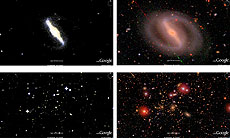Fermilab postdoc improves Google Sky galaxy views
 |
Galaxy images before (left) and after co-adding. Image courtesy of Jiangang Hao. |
With their palette of celestial hues, galaxies are among the most beautiful objects in the universe. Now a Fermilab postdoc, Jiangang Hao, has made the jewel-toned images from the Sloan Digital Sky Survey sharper, deeper, and even more accessible to the public by adding them to the Google Sky database.
Created in 2007 as an extension of Google Earth, Google Sky compiles SDSS images to allow indoor, amateur astronomers to dynamically scan and zoom through the sky with a flick of a mouse rather than flipping through lists of images. But most of Google Sky’s pictures are intentionally low-quality to allow for quick download speed. Faraway objects such as galaxies are particularly fuzzy and are black and white.
This can be limiting for astronomers, who need full color to determine a galaxy’s position. Like an ambulance siren that changes its tone as it moves further away, a galaxy’s color appears redder the more distant from us it is: a phenomenon known as redshift.
“If you see a small galaxy, you can’t always tell if that’s its intrinsic size or its distance,” Hao said. “Color is a better way to tell distance.”
To get better images of distant objects, astrophotographers can use either a long exposure, which often results in a blurred image, or a technique called co-adding, where multiple images are stacked on top of one another so that bright spots are amplified.
Hao and fellow Fermilab astrophysicist Jim Annis did the latter with one strip of the sky, co-adding more than 3 million full-color SDSS images and converting the stacks into a file format that Google Sky could understand. The files are available for download from their website, and the data are hosted off of Fermilab’s servers.
“This was easier than building our own system,” said Annis, who helped co-add the color data. “The Google Sky system lets it be visible.”
Making the data publically available may prove useful for Hao’s own research into how gravitational attraction affects galaxy clusters. The human eye is better than a computer at detecting clusters and patterns, and astronomy enthusiasts on sites such as Galaxy Zoo have already begun characterizing and classifying the new, sharper images. Hao and Annis’ website has received thousands of hits since its launch Oct. 31.
“With color images, it’s easier to get the public interested in this kind of research,” Hao said. “We can make use of all that brainpower for scientific research.”
There’s still a long way to go; the deep images make up only 300 of the 40,000-square degrees of the sky. Hao is looking forward to the deep images of the southern sky that the Dark Energy Camera in Chile will produce over the next five years. He’s broken the ground for others to help compile this data: a paper he and Annis uploaded to the arXiv database describes the co-adding technique.
“Galaxy clusters,” begins its abstract, “are spectacular.”
-- Sara Reardon
|